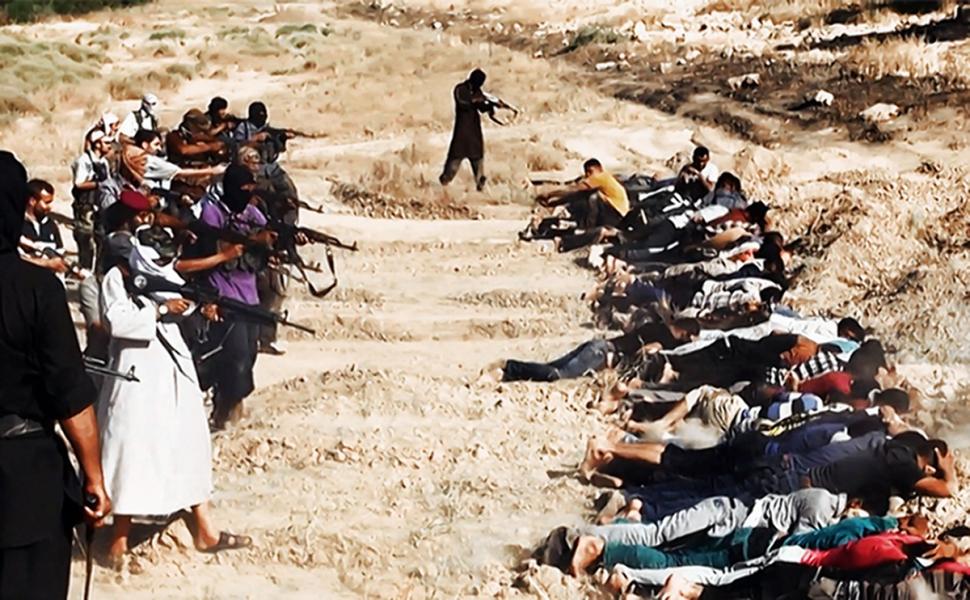Two different survivors of a massacre committed by ISIS at Camp Speicher near Tikrit, Iraq back in June, tell two different stories. And the explanations for what happened range from mere cowardice on the part of the Iraqi commanders, to the foulest treachery.
Ali Hussein Kadhim, an Iraqi soldier and a Shiite, was captured with hundreds of other soldiers by ISIS militants, but managed to escape after bullets from their firing squad managed to miss him. He fell down and feigned death until he had a chance to crawl out of a freshly dug trench.
Kadhim is one of a small handful of soldiers who survived the massacre of up to 1,700 Shiite soldiers which the New York Times points out makes it “the deadliest sectarian atrocity in Iraq’s recent history, reminiscent of the mass killings carried out by Mr. Hussein’s government – more reminiscent of the mass killings carried out by Mr. Hussein’s government than anything the country faced during the sectarian civil war in 2006 and 2007.”
The Iraqi government believes there are still hundreds of other soldiers from the base being held in Anbar Province.
Here’s Kadhim’s story as told by Tim Arango of the New York Times, suggesting incompetence and cowardice on the part of the Iraqi commanders.
After militants stormed Mosul, Iraq’s second-largest city, on June 10, they continued their offensive south toward Tikrit. In Tikrit, chaos and fear enveloped Camp Speicher, where Mr. Kadhim, a trainee who had joined the army just 10 days before Mosul fell, was posted. The American-trained army officers fled, as they had in Mosul, Mr. Kadhim said.
“We were alone,” he said. “So we decided to flee, because there were no officers.”
He and his comrades took off their uniforms, put on civilian clothes — track suits and sandals for many of them — and, in a large group that Mr. Kadhim said amounted to about 3,000 soldiers, started walking out the front gates.
It was a terrible decision and a cruel fate: To this day, Camp Speicher has not fallen to ISIS. Had Mr. Kadhim and his friends stayed where they were, they would almost certainly have been safe.They thought they would walk as far as Baghdad, almost 120 miles south.
But just a few miles down the road, near Tikrit University, the men ran in to a group of about 50 ISIS fighters in armored vehicles, he said.
The AP reported another survivor’s story which strongly suggests that one of their commanders set them up.
At Wednesday’s parliament session, the soldiers’ families accused authorities of “selling our sons” by ordering many of the soldiers to abandon their posts and leave Camp Speicher in civilian clothes.
Once outside the base, hundreds were captured, said Mohammed al-Assi, a representative for the soldiers’ families.
However, acting Defense Minister Saadoun al-Dulaimi denied any orders to abandon Camp Speicher.During the parliament session, survivor Thaer Abdul-Karim told lawmakers that a military commander ordered the soldiers in Speicher on June 12 to leave the camp and hand over their weapons .
Abdul-Karim said the commander told the troops that there were military trucks waiting for them at a nearby highway to take them to a base near Baghdad. Instead, the soldiers, in civilian clothes, were taken by gunmen who were waiting for them on the highway.
The gunmen later ordered batches of prisoners to go out and started to shoot them.“We panicked after seeing our colleagues being shot dead,” Abdul-Karim said. “There was a state of chaos and some started to run away and I managed to escape from the place.”
The Times’ Tim Arango writes, “the story of the massacre tells as much about the woeful state of the Iraqi military, a force created and trained by the United States at a cost of billions of dollars, as it does about the cruelty of ISIS.”
In his book, A Floweshop in Baghdad, retired Major Michael Banzet, an American Air Force Pilot who spent a year in Iraq training young Iraqi Air Force recruits, agrees there were some bad eggs in the Iraqi military – holdovers from the Saddam era – who needed to be phased out. He told me the United States Military was working on that. Until they were forced to leave. The future of Iraq could be seen in the bright and intelligent faces of the young recruits.
Banzet said, “Tikrit used to be where the Iraqis conducted pilot training, and even though we were using Kirkuk (much safer), the Iraqis were determined to get back there. It meant a lot to them. So, I helped start a process to induct young Iraqi AF recruits. The wonderful Iraqi buddies that I worked with for a year worked hard to keep it going. We knew there were a lot of senior- mid level Iraqi leaders that needed to be transitioned out, but we just didn’t have enough of the good ones. But, hey, we would be there, right?”
Banzet is convinced things would have turned out differently if the Americans had still been there to help guide the commanders and the recruits. “Courage gathers courage,” he said. “Cowardice gets people killed.”
“No way in HELL we wouldn’t have headed that off. I think I talk about it in my book. Sometimes the Americans would just be ‘portable spines.'”

COMMENTS
Please let us know if you're having issues with commenting.